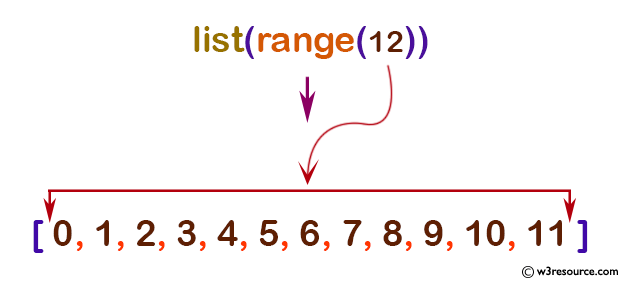Python: range() function
range() function
The range() function is used to get a sequence of numbers, starting from 0 by default, and increments by 1 by default, and ends at a specified number.
Note: Sequence Types - list, tuple, range etc.
Version:
(Python 3.2.5)
Syntax:
range(stop) range(start, stop[, step])
Parameter:
| Name | Description | Required / Optional |
|---|---|---|
| start | An integer number specify starting position. Default is 0. |
Optional. |
| stop | An integer number specify end position. Default is 0. |
Optional. |
| step | Increment between each integer in the sequence. Default is 1 | Optional. |
Return value:
Returns an immutable sequence object of integers.
Example-1: Python range() function
# empty range
print(list(range(0)))
# using range(stop)
print(list(range(12)))
# using range(start, stop)
print(list(range(1, 15)))
Output:
[] [0, 1, 2, 3, 4, 5, 6, 7, 8, 9, 10, 11] [1, 2, 3, 4, 5, 6, 7, 8, 9, 10, 11, 12, 13, 14]
Pictorial Presentation:

Pictorial Presentation:

Example-2: Python range() function
print(range(10))
print(range(0, 30, 5))
print(range(0, -10, -1))
Output:
# range upto 10 print(range(10)) # range upto 30 but 5 step jumps print(range(0, 30, 5)) # range() works with negative print(range(0, -10, -1))
Example-3: Python range() works with negative step
# range upto 10
print(list(range(10)))
# range upto 30 but 5 step jumps
print(list(range(0, 30, 5)))
# range() works with negative step
print(list(range(0, -10, -1)))
Output:
[0, 1, 2, 3, 4, 5, 6, 7, 8, 9] [0, 5, 10, 15, 20, 25] [0, -1, -2, -3, -4, -5, -6, -7, -8, -9]
Python Code Editor:
Previous: property()
Next: repr()
Test your Python skills with w3resource's quiz
